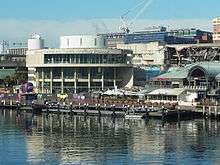Sydney Convention and Exhibition Centre
| Sydney Convention and Exhibition Centre | |
|---|---|
 Sydney Convention and Exhibition Centre | |
| General information | |
| Status | Currently Under Re-construction |
| Type | Convention center |
| Architectural style | Modern architecture |
| Address | Darling Harbour |
| Town or city | Sydney |
| Country | Australia |
| Opening | 1988 |
| Renovated | 2013 - 2016 |
| Owner | NSW Government |
| Technical details | |
| Floor count | 3 |
| Renovating team | |
| Renovating firm | 2013 Redevelopment: AEG Ogden, Lend Lease, Capella Capital and Spotless |
| Website | |
|
www | |
The Sydney Convention and Exhibition Centre closed in 2013. Australia’s first fully integrated convention, exhibition and entertainment precinct, named International Convention Centre Sydney, is being built on its footprint and will open in December 2016. The new venue is part of a AU$3.4b revitalisation of Darling Harbour by the NSW Government.
An interim facility for large consumer and trade shows, Sydney Exhibition Centre @ Glebe Island, opened in February 2014 and will operate during the construction of the new Darling Harbour facilities.
History
The Sydney Convention and Exhibition Centre was a key meeting venue of APEC Australia 2007 in September, 2007 when the political leaders of the 21 member states of the Asia-Pacific Economic Cooperation met. The venue was host to the Business Leader's Summit held in conjunction with APEC Leader's Week.
The Sydney Convention and Exhibition Centre was officially opened in 1988, with a new section of the centre added for the 2000 Summer Olympics. During those games, the venue played host to the boxing, fencing, judo, weightlifting, and wrestling competitions. The building was owned by the State Government of New South Wales, with the centre administration and business run by the Accor Hotel Group. The Sydney Convention and Exhibition Centre was used as a conference and convention venue and to hold exhibitions, as well as hosting various smaller events such as weddings and meetings. The Convention Centre had around 30 rooms, ranging from small meeting rooms to a 3500 capacity auditiorium, as well as foyer areas and other spaces which can be adapted for use as an exhibition space or pre-dinner function venue. The Exhibition Centre consisted of six halls, used primarily for exhibitions, but also for gala dinners and other large-scale events.
The Sydney Convention and Exhibition Centre was used as the biggest venue for the Sydney Olympic Games outside of Sydney Olympic Park.[1]
Transport
The Sydney Monorail and Inner West Light Rail provided public transport to the centre. The monorail opened in 1988 and shut down in 2013. The light rail opened in 1997. The Convention and Exhibition Centre stations are named after the Sydney Convention and Exhibition Centre.
Architecture Award
The 1989 Sir John Sulman Medal for Public Architecture was awarded to Philip Cox Richardson Taylor Partners for Sydney Exhibition Centre, Darling Harbour (joint winner).
Criticism of Demolition


Architects John Andrews and Philip Cox spoke out over the demolition of the convention and exhibition buildings completed in 1988. The Sydney Morning Herald carried the following story on January 16, 2014:
The renowned architect has spoken out for the first time on a plan to demolish the Sydney Convention Centre at Darling Harbour, blasting it as "rather stupid"."Does it make sense to pull down $120 million worth of [building] that's perfectly all right?" he said. "As Australia, we just haven't grown up, we haven't developed any good manners and we don't protect and look after our good things." Andrews, 79, joins architect Philip Cox, who designed the adjoining exhibition centre, in lambasting plans to destroy the buildings rather than incorporate them into the new design.
Infrastructure NSW says Sydney needs world-class facilities to more effectively compete for large events, and the existing buildings are too small to meet demand. But Mr Andrews questioned why the centre couldn't be expanded. "I don't understand why the [new] architects … are so keen to knock everything down, he said. Why don't they just reuse things and add to them?"
Authorities did not ring to advise him of the building's pending demolition - he learnt of it while reading the newspaper. Considered one of Australia's most important architects, Mr Andrews is renowned for the futuristic Intelsat Headquarters in Washington, the CN Tower in Toronto and the Graduate School of Design at Harvard University.
In Australia, he designed the Cameron Offices in Canberra, the American Express Tower in Sydney and convention centres in Melbourne and Adelaide. The decision to destroy the semi-circular convention centre displayed "a lack of understanding of history, of architecture or city planning", he said.
An INSW spokeswoman said until the Lend Lease consortium was announced as the chosen developer last month, "we didn't have a proposal to discuss with any architect". The Sydney Harbour Foreshore Authority was legally obliged to consult with the architects "only a few weeks prior to demolition", however, it planned to "go beyond the requirement to ensure the relevant architects have plenty of time to understand the proposed development, provide their feedback and record their work," the spokeswoman said.[2]
References
External links
![]() Media related to Sydney Convention and Exhibition Centre at Wikimedia Commons
Media related to Sydney Convention and Exhibition Centre at Wikimedia Commons
Coordinates: 33°52′33″S 151°12′01″E / 33.87585°S 151.20015°E




